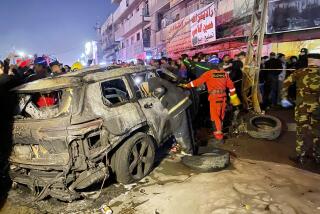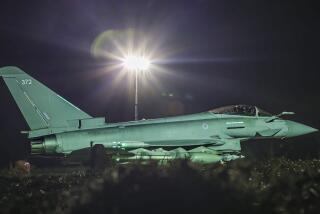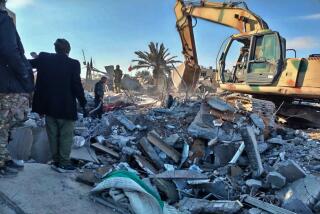Civilian casualties from airstrikes grow in Iraq and Syria. But few are ever investigated

A recent airstrike by the U.S.-led coalition in Iraq is believed to have caused more than 270 civilian deaths, a tragedy that provoked an international outpouring of grief and outrage.
But the uproar over the March 17 deaths in the Jadidah neighborhood of Mosul masks a grim reality: Hundreds, and perhaps thousands, of other civilians have died in hundreds of airstrikes in Iraq and Syria during the war against Islamic State, and it appears likely that the vast majority of those deaths were never investigated by the U.S. military or its coalition partners.
It also appears that the number of civilian casualties has risen in recent months as combat has shifted to densely populated west Mosul and the coalition has undertaken the heaviest bombing since the war began almost three years ago.
The Pentagon insists the written rules of engagement in Iraq and Syria have not changed, but there are signs that military commanders on the ground are more empowered under President Trump.
Raed Mohammed Hasan, 30, said he lost neighbors and relatives, including his 11-month-old daughter, Rania, in an airstrike in east Mosul on Jan. 21. He and other residents say 11 civilians died in that strike, which occurred during the months-long battle to oust Islamic State from Iraq’s second-largest city. Coalition records show a strike was carried out in Mosul that day, but officials say it is not being investigated for civilian deaths.
“They told us it was a mistake by the coalition, and after the war we will talk about it,” Hasan said of Iraqi officials whom he contacted for help. “Why would they make a mistake like this? They have all the technology. This is not a small mistake.”
Another east Mosul resident, Jasim Mohammed Ali, said his son and six grandsons were killed by what he believes was a coalition airstrike that destroyed his home on Nov. 17.
The coalition is still investigating the strike based on a complaint by Human Rights Watch, which — along with other experts The Times consulted — identified munition parts in the wreckage of Ali’s house as a GBU-39 small-diameter bomb, a guided munition used by coalition forces.
Ali said that during the attack in the modest Aden neighborhood, his grandsons were crushed by rubble in their bedroom as he cowered next door with his 17-year-old son, who was also killed. His pregnant daughter-in-law lost her baby, a girl who had yet to be named. His wife suffered scarring burns to her head and back. His daughter’s legs were crushed as she tried to hold her 6-year-old son, buried beneath the concrete. Although surgeons inserted metal pins in her legs, she still can’t walk.
Unable to reach the cemetery because of fighting, the family buried the bodies in a nearby schoolyard, marking the graves with cinder blocks.
“Why did they hit us?” Ali asked.
One possible explanation: Neighbors said they saw Islamic State militants lurking outside the house before the strike, but they survived it and fled.
As a practice, the U.S. military refuses to release details about civilian casualties under review. But comprehensive, hands-on investigations are rare. Commanders have ordered only a handful since the campaign against Islamic State — also known by the acronyms ISIS and Daesh — began in Iraq and Syria in 2014.
The coalition investigates civilian casualties based on reports from its staff, the news media, social media and independent monitoring groups such as the London-based Airwars, Human Rights Watch and Mosul Ateka, a volunteer network of current and former Mosul residents.
The monitors say there have been more civilian casualties than the coalition has reported. The coalition has acknowledged that this is likely true.
Coalition warplanes have carried out 20,205 strikes in Iraq and Syria since 2014, according to the latest published numbers, which the Pentagon says have aided in the killing of more than 70,000 militants. Yet Pentagon officials also claim to have killed just 229 civilians over that time.
But Airwars, a nonprofit with a staff of journalists and researchers who keep detailed records and conduct independent research, said its figures showed at least 3,111 civilians have been killed in 552 strikes for which it has significant evidence: Either the coalition has specifically confirmed the strikes, or it has confirmed strikes in the area on that date and Airwars has two or more credible sources.
Airwars has also tracked an additional 610 reports of strikes in which civilians were killed based on a single source or contested claims, which could mean that several thousand additional civilians have been killed.
The coalition, which has confirmed civilian casualties in 102 airstrikes, said it is currently investigating an additional 42 strikes that may have caused civilian casualties in Iraq and Syria.
Micah Zenko, a senior fellow at the nonpartisan Council on Foreign Relations, said history suggests the Pentagon is drastically underreporting civilian casualties.
“It’s an implausible number when compared to any other air campaign in history,” he said. “It just doesn’t add up when you look at the number of munitions being dropped.”
U.S. Army Col. Joe Scrocca, a Baghdad-based spokesman for the coalition, conceded its civilian casualty counts are conservative, requiring multiple confirmations, and said the real total probably lies “somewhere in the middle” of the coalition tally and Airwars’.
Military reports usually do not include accounts from the scene, he said, because many are in enemy territory. They don’t often include interviews with victims and other witnesses because they can be difficult to identify and find, he said.
“We don’t have any means of going and searching out people and, honestly, we don’t have the manpower,” he said.
Criticism is mounting, however, by those who say the coalition could do a much better job of avoiding civilian casualties.
In past wars, U.S. troops on the ground helped provide targeting information and intelligence. But in the battle against Islamic State, commanders rely chiefly on airborne surveillance, captured communications chatter, signals intelligence and images captured by drones circling overhead. Information may also come from Iraqi forces, who are coming under fire and in desperate need of air cover.
After the Jadidah strike, U.S. Rep. Ted Lieu (D-Torrance), a former Air Force prosecutor, sent a letter to Defense Secretary James N. Mattis demanding details on military operations that have resulted in an uptick in civilian casualties.
“The substantial increases in civilian deaths caused by U.S. military force in Syria and Iraq brings into question whether the Trump administration is violating the Law of War,” Lieu wrote. “The large number of civilian casualties also suggests a possible breakdown in target selection, intelligence gathering, or operational execution.”
Military officials say the Mosul campaign is especially difficult because it is fought in densely packed neighborhoods of old houses, many with basements where families take shelter out of sight. Before the offensive launched Oct. 17, Iraqi officials dropped leaflets and aired television advisories urging residents to stay home rather than flee, promising the military would protect them.
Airwars recorded more than 160 strikes with civilian casualties last month, an all-time monthly high and a 400% increase compared with six months earlier.
“This is the most significant urban combat to take place since World War II; it is tough and brutal,” said Lt. Gen. Stephen Townsend, commander of U.S. forces in Iraq and Syria. “House-by-house, block-by-block fights.”
In December, Townsend delegated authority to call in airstrikes to U.S. commanders closer to the front lines, rather than back at headquarters. That means there are fewer double-checks on whether to launch a strike, and they are called in quicker. He acknowledged that “our partners in the coalition have made mistakes that have harmed civilians,” but insisted, “We have never targeted them, not once.”
U.S. forces have blamed Islamic State in some cases for using civilians as human shields — or apparently packing buildings full of civilians and stationing snipers on the roofs in what may be a concerted effort to lure airstrikes and cause civilian casualties.
Some survivors of airstrikes agree that Islamic State bears responsibility, but also wonder why militants sometimes have time to escape while civilians die.
Raed Mohammed Hasan, who survived the Jan. 21 strike in east Mosul, said that shortly before the attack, he could hear militants just outside, using a laptop, radio and drone. They escaped the attack, he said.
A few streets away, Omar Hasan Abdul Qadir said militants forced his family inside before an airstrike on Jan. 17 that killed eight people, including four of his grandchildren.
Qadir wants to rebuild, but standing near the wreck of his home in a gray robe and blazer, holding his now motherless 2-year-old grandson, he broke down.
“Because of Daesh, they shot it,” he said, referring to the house.
Occasionally, the coalition reopens investigations. Last month, it confirmed a strike from Sept. 20, 2015, that killed a professor, his 17-year-old son and two other relatives in east Mosul.
Scrocca apologized for the delay, but said the fact that the case was ultimately concluded “demonstrates that we didn’t blow this off. We fully admit that it was a mistake.”
Zareena Grewal, a relative of the victims, called it “a small relief to have the U.S. government concede that this airstrike was a mistake, that they mistakenly targeted the residential homes of a family that opposed ISIS.”
Grewal, an associate professor of American and religious studies at Yale, said the finding was also “deeply frightening … an indictment of the quality of U.S. intelligence.”
Airwars Director Chris Woods said that as the Mosul offensive intensifies, the coalition should do more to identify and investigate a backlog of civilian casualties. He said it’s troubling that victims and other witnesses are usually not interviewed.
“Any investigation into civilian casualties that thinks the perspective of surviving family members is not necessary is a flawed process,” he said.
Karim Sinjar, a former Mosul resident who helped found Mosul Ateka, said the coalition needs to better review strikes with civilian casualties and improve the way it targets militants in crowded neighborhoods. His group relays information from Mosul residents living under Islamic State to Iraqi authorities in an effort to minimize civilian casualties.
A two-member team assesses civilian airstrike casualties for the coalition. It is still evaluating reports from January, plus about 700 reports shared by Airwars on strikes since October.
“There is a backlog. You can only do so many at a time and still conduct the war,” Scrocca said.
The strikes can be difficult to investigate independently. Last month, Iraqi special forces restricted press access to west Mosul, where many of the latest strikes occurred, after The Times visited the site of the Jadidah strike. Coalition officials referred requests to enter the area to Iraqi authorities.
In the western neighborhood of Mahata, numerous buildings appeared to have been bombed, their roofs collapsed and spilling into streets still choked with burned cars and other debris.
At one residential compound that had been reduced to a heap of crumbling concrete and tangled rebar, residents said, a March 13 airstrike killed at least 21 people, including four children, in three houses. Victims and witnesses said 60 people were in the houses at the time.
None had been contacted by Iraqi or coalition authorities, but a coalition spokesman said they were investigating.
Malak Aaid, 9, remembered hiding under the stairs during the attack, and emerging to find that her 2-year-old cousin had been killed.
“My father was crying. My sister and brother, their bodies were broken and they’re in the hospital,” she said. “We don’t have a home anymore.”
Malak has had dreams about the attack, which also killed her mother. She had yet to see her mother’s grave, because militants were still shelling the area.
Her uncle, Adnan Ahmed Aaid, 25, was still on crutches earlier this month, his right leg broken in the attack. Standing in the rain with other victims, he surveyed the remains of his home and said he hoped the U.S. government would repay him.
“Otherwise, no one else is going to compensate us,” he said.
Even when the coalition acknowledges an error, Scrocca said, there is no formal compensation process for airstrike victims.
“In certain circumstances families can request, and we may give them, an expression of our sympathy,” he said. “It’s not meant to be compensation for lost loved ones. We do try to show our sorrow.”
Mohammed Mumtaz lost eight members of his family and his new house in east Mosul when an airstrike targeted militants across the street on Dec. 11.
Only Mumtaz, 30, and his 8-year-old son, Yaman, managed to scale a gate and escape. The coalition is still investigating after learning of the reported civilian casualties from Human Rights Watch.
“I don’t think I’m going to get anything,” said Mumtaz, a pharmacist, as he watched his son play outside a relative’s house where they’re staying. “I have to start from zero.”
Hennessy-Fiske reported from Mosul and Hennigan from Washington.
molly.hennessy-fiske@latimes.com
ALSO
U.S. military says misdirected airstrike in northern Syria killed 18 allied fighters
Syrian villagers near U.S. missile strike know the sound of battle — but never as horrific as this
New report shows mounting number of civilians killed in Iraq
More to Read
Start your day right
Sign up for Essential California for news, features and recommendations from the L.A. Times and beyond in your inbox six days a week.
You may occasionally receive promotional content from the Los Angeles Times.








